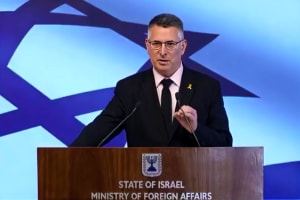Undeclared Iranian nuclear site was hit by Israeli strikes last month, significantly delaying regime’s plans – report
Report reveals Parchin complex contained critical equipment to build nuclear bomb

As part of its wave of airstrikes on Iranian territory during October, Israel destroyed several buildings that were critical for the regime’s nuclear program, severely hampering its progress, according to an Axios report.
After the second Iranian missile assault on Israel, the Biden administration pushed Israel not to strike the regime’s nuclear sites to avoid an all-out regional war. Despite agreeing to the request, satellite images taken shortly after the strikes revealed that four buildings within the Parchin complex, previously known for its nuclear research activities, were destroyed.
As a reminder, the Taleghan 2 complex (which Axios references) was clearly hit in the strike - but assumed to be unused. Either it was in fact being used, or something else in Parchin was hit https://t.co/EMU11toEj1 pic.twitter.com/JwtfLQRl4Q
— Michael A. Horowitz (@michaelh992) November 15, 2024
Informed Israeli officials have now told Axios that one of the buildings, “Taleghan 2,” contained sophisticated equipment that will be necessary for Iran to create a nuclear device, thus effectively halting the program until the regime finds a replacement.
Israeli intelligence believes it will be able to recognize if the regime attempts to buy and import the equipment, enabling measures to prevent it.
“This equipment is a bottleneck. Without it the Iranians are stuck,” a senior Israeli official said.
At Parchin, the old Taleghan 2 building was attacked for more than one reason, according to an Israeli government source. But the one he would confirm was to send a signal. Remember the Iranians claimed they never had any nuclear activity at this site, so Iran (or others) cannot… pic.twitter.com/spWlg5BU0T
— Inst for Science (@TheGoodISIS) November 5, 2024
“This is equipment the Iranians would need in the future if they want to make progress towards a nuclear bomb. Now they don't have it anymore and it is not trivial. They will need to find another solution and we will see it,” another Israeli official said.
Israel decided to target the four buildings despite assurances to the U.S., based on the assessment that, since the site was undeclared, Iran could not acknowledge the strike as an attack on its nuclear program without admitting to violating the nuclear non-proliferation treaty.
“The strike was a not-so-subtle message that the Israelis have significant insight into the Iranian system even when it comes to things that were kept top secret and known to a very small group of people in the Iranian government,” according to a U.S. official.
The Taleghan 2 building contained sophisticated equipment to design the plastic explosives used to detonate the radioactive uranium core of a nuclear bomb, dating back to before 2003, when Iran officially ended its nuclear program.
Over the past year, numerous media reports suggested that the U.S. and Israel had recognized signs that Iran had resumed and accelerated its nuclear research.
“They conducted scientific activity that could lay the ground for the production of a nuclear weapon. It was a top secret thing. A small part of the Iranian government knew about this, but most of the Iranian government didn't,” a U.S. official said.
The regime has consistently denied it is seeking nuclear weapons, with Iranian Foreign Minister Abbas Araghchi declaring just last week: “Iran is not after nuclear weapons, period.”
According to the Institute for Science (ISIS), a nuclear nonproliferation think tank, the three other buildings destroyed, in addition to Taleghan 2, contained parts associated with rocket motor production and were related to “the mixing and casting of the propellants in the production of solid rocket motors for large motor missiles.”
This building at Parchin, part of Iran’s crash nuclear weapons program of the early 2000s, originally contained a specially built high explosive chamber and a flash x-ray able to peer deeply into a high explosive experiment. 2/
— Inst for Science (@TheGoodISIS) October 28, 2024
See: https://t.co/QIwHpWfw0P pic.twitter.com/hzc3VRhFgn
According to the institute, Taleghan 2 served as a nuclear weapons development test location decades ago, at the time containing a high explosive test chamber and a flash x-ray system, powered by a Marx generator, capable of taking detailed photos of an explosion.
“It is not certain whether Iran used uranium at Taleghan 2, but it is possible it studied the compression of natural uranium hemispheres, which would explain its hasty and secretive renovation efforts following the IAEA’s request to access Parchin in 2011. However, the IAEA never visited the building.”
The chief of the UN nuclear watchdog IAEA (International Atomic Energy Agency), Rafael Grossi, visited Iran on Wednesday and Thursday for meetings with Iranian officials and visited the Fordow and Natanz nuclear sites.
During the visit, Grossi declared that Iran’s nuclear installations “should not be attacked,” emphasizing that achieving results in the talks with Iran was crucial to avoid an expanded war.

The All Israel News Staff is a team of journalists in Israel.
You might also like to read this:















